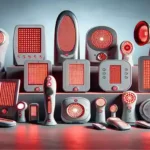Lighting is a vital element in healthcare environments, impacting both patient well-being and staff efficiency. Effective “Healthcare Lighting” goes beyond simple illumination—it shapes spaces that foster healing and reduce stress. From bright, focused lighting in operating rooms to calming, adjustable lights in patient rooms, every area within a healthcare facility needs tailored solutions that support safety, comfort, and optimal performance for all who interact with the space.
Understanding Healthcare Lighting
What Is Healthcare Lighting?
Healthcare lighting refers to lighting systems designed specifically for medical environments. It includes a wide range of fixtures and technologies tailored to meet the needs of patients, visitors, and healthcare professionals.
Key Goals and Objectives
The main goal of healthcare lighting is to support patient care. It should enhance visibility for medical procedures while ensuring patient comfort. Additionally, it aims to reduce energy consumption and comply with health and safety standards.
Types of Healthcare Lighting
Ambient Lighting in Hospitals
Ambient lighting provides general illumination. It creates a balanced environment, reducing harsh shadows. This type of lighting is essential in lobbies, corridors, and patient rooms.
Task Lighting for Precision
Task lighting focuses on specific areas. Surgeons and healthcare workers depend on this lighting for precision during procedures. It often includes adjustable lights to target specific zones.
Accent Lighting for Aesthetics
Accent lighting enhances the visual appeal of a space. It’s commonly used in reception areas or lounges to create a welcoming atmosphere.
Benefits of Proper Healthcare Lighting
Enhancing Patient Recovery
Studies show that proper lighting can speed up patient recovery. Exposure to natural light, for example, improves mood and reduces hospital stays.
Reducing Staff Fatigue
Healthcare workers often work long hours. Well-designed lighting minimizes eye strain and boosts focus, helping staff perform their duties efficiently.
Improving Safety and Accuracy
Bright, well-placed lighting reduces the risk of errors during medical procedures. It also prevents accidents, such as trips or falls, in high-traffic areas.
Lighting for Patient Comfort
Natural Light Integration
Natural light has a calming effect on patients. Hospitals with large windows or skylights help patients feel more relaxed and connected to the outside world.
Adjustable Lighting Systems
Adjustable lights allow patients to control the brightness in their rooms. This flexibility improves their comfort and promotes better sleep cycles.
Non-Glare Technologies
Non-glare lighting reduces eye strain and creates a soothing environment, which is especially important for patients who spend long hours in bed.
Lighting for Healthcare Workers
Healthcare professionals need proper lighting to carry out their tasks effectively.
Supporting Long Shifts
Bright, focused lighting helps healthcare workers stay alert during long shifts. It minimizes fatigue and boosts productivity.
Task-Specific Lighting Designs
From reading charts to performing surgeries, healthcare workers rely on task-specific lighting. These designs ensure clear visibility and reduce the chances of mistakes.
Energy Efficiency in Healthcare Lighting
LED Lighting in Hospitals
LED lighting is a popular choice in healthcare settings. It consumes less energy, lasts longer, and provides better illumination than traditional lighting options.
Smart Lighting Systems
Smart lighting adapts to the needs of the environment. For instance, motion sensors can automatically adjust brightness, saving energy in unused areas.
Sustainability Benefits
Energy-efficient lighting reduces the carbon footprint of healthcare facilities. It also lowers utility costs, which can be reinvested into patient care.
Role of Lighting in Specialized Medical Areas
Surgical Suites
Surgeons need precise lighting to perform complex procedures. Surgical lights are designed to minimize shadows and provide bright, focused illumination.
Emergency Rooms
In emergency rooms, lighting must be bright and reliable. It helps medical staff make quick decisions and ensures patient safety.
Patient Recovery Areas
Soft, adjustable lighting in recovery areas creates a calming atmosphere. It helps patients relax and aids in their healing process.
Psychological Impact of Healthcare Lighting
Mood and Recovery Rates
Lighting affects mood and mental health. Bright, natural light can reduce feelings of depression and anxiety, improving recovery rates.
Reducing Stress in Patients
Soothing lighting designs can reduce stress for patients and their families. Warm color tones and dimmable features contribute to a sense of calm.
Importance of Color Temperature
Color temperature plays a vital role in healthcare lighting. Cooler tones are used in operating rooms for clarity, while warmer tones are ideal for patient rooms.
Technological Advancements in Healthcare Lighting
Smart Lighting Integration
Smart lighting systems use sensors and automation to optimize illumination. They adjust brightness and color temperature based on the time of day or activity.
Circadian Rhythm Lighting
Lighting that mimics natural light cycles helps regulate sleep patterns. This technology is particularly beneficial for patients in long-term care.
Remote Monitoring Systems
Advanced lighting systems allow remote adjustments. Facility managers can control brightness and energy usage from a central system.
Designing Effective Healthcare Lighting Plans
Involving Architects and Designers
Collaborating with architects ensures lighting plans align with the building’s design. This teamwork creates cohesive and functional spaces.
Compliance with Regulations
Healthcare facilities must adhere to strict lighting regulations. Proper planning ensures compliance while meeting the needs of patients and staff.
Common Challenges in Implementing Healthcare Lighting
Budget Constraints
High-quality lighting systems can be expensive. However, the long-term benefits often outweigh the initial costs.
Maintenance Challenges
Regular maintenance is essential for healthcare lighting. Hospitals must invest in durable, low-maintenance options to reduce downtime.
Balancing Aesthetics with Functionality
While aesthetics are important, functionality should never be compromised. Effective planning strikes the right balance.
Lighting Regulations in Healthcare Facilities
Overview of Compliance Standards
Healthcare lighting must meet standards set by regulatory bodies. These standards ensure safety and effectiveness.
Importance of Adhering to Safety Guidelines
Non-compliance can lead to penalties and safety risks. Following guidelines protects both patients and staff.
International Comparisons
Different countries have varying regulations for healthcare lighting. Understanding these differences helps global healthcare providers maintain high standards.
Future Trends in Healthcare Lighting
AI-Driven Lighting Solutions
Artificial intelligence is transforming healthcare lighting. AI systems can predict maintenance needs and optimize energy use.
Personalized Patient Lighting
Future technologies may allow patients to customize lighting based on their preferences, enhancing their comfort.
Innovations on the Horizon
From solar-powered systems to advanced LED designs, the future of healthcare lighting is bright.
How to Choose the Right Healthcare Lighting Solutions
Key Considerations
Factors like energy efficiency, durability, and patient comfort should guide decision-making.
Vendor Selection Process
Choosing the right vendor is critical. Look for companies with a proven track record in healthcare lighting.
Balancing Cost and Quality
It’s essential to find a balance between affordability and quality. Investing in durable, energy-efficient systems pays off in the long run.
Conclusion
Healthcare lighting is more than just a technical requirement; it’s a cornerstone of effective patient care. Investing in advanced, well-designed systems benefits everyone in the healthcare ecosystem. With ongoing innovations, the future of “Healthcare Lighting” looks promising.






